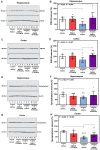WS635 Attenuates the Anesthesia/Surgery-Induced Cognitive Impairment in Mice
- PMID: 34366827
- PMCID: PMC8335586
- DOI: 10.3389/fnagi.2021.688587
WS635 Attenuates the Anesthesia/Surgery-Induced Cognitive Impairment in Mice
Abstract
Anesthesia/surgery has been reported to be associated with perioperative neurocognitive disorder (PND) in patients and induces cognitive impairment in mice. Previous studies demonstrate cyclosporine A (CsA) attenuates the anesthesia/surgery-induced cognitive impairment in mice. However, CsA has immunosuppressive effects and may not be routinely used to prevent or treat PND in patients. WS635 is a nonimmunosuppressive CsA analog. We, therefore, set out to determine whether WS635 could mitigate the anesthesia/surgery-induced cognitive impairment in mice. We performed abdominal surgery under 1.4% isoflurane anesthesia (anesthesia/surgery) for 2 h in 9 month-old wild-type (WT) mice. We treated the mice with CsA (10 mg/kg) or different doses (13.2 mg/kg, 26.4 mg/kg and 52.8 mg/kg) of WS635 before and after the anesthesia/surgery. Barnes maze and fear conditioning system (FCS) were employed to evaluate the cognitive function in mice. We measured the amounts of postsynaptic density (PSD)-95, synaptophysin, and ATP in the hippocampus and cortex of the mice using western blot and ATP Colorimetric/Fluorometric Assay, respectively. We found that the treatment with 52.8 mg/kg, but not 13.2 mg/kg or 26.4 mg/kg, of WS635 attenuated the anesthesia/surgery-induced cognitive impairment in mice and the reductions in the amounts of PSD-95, synaptophysin, and ATP in the mice brain tissues. These results have established a system to study WS635 further and suggest that we need to perform more experiments to determine whether WS635 can ultimately be used as one of the interventions for PND in patients.
Keywords: ATP; WS635; anesthesia/surgery; cognitive impairment; synapse.
Copyright © 2021 Lin, Shen, Lu, Liang, Zhang, Xie and Dong.
Conflict of interest statement
The authors declare that the research was conducted in the absence of any commercial or financial relationships that could be construed as a potential conflict of interest.
Figures







References
Grants and funding
LinkOut - more resources
Full Text Sources
Other Literature Sources

